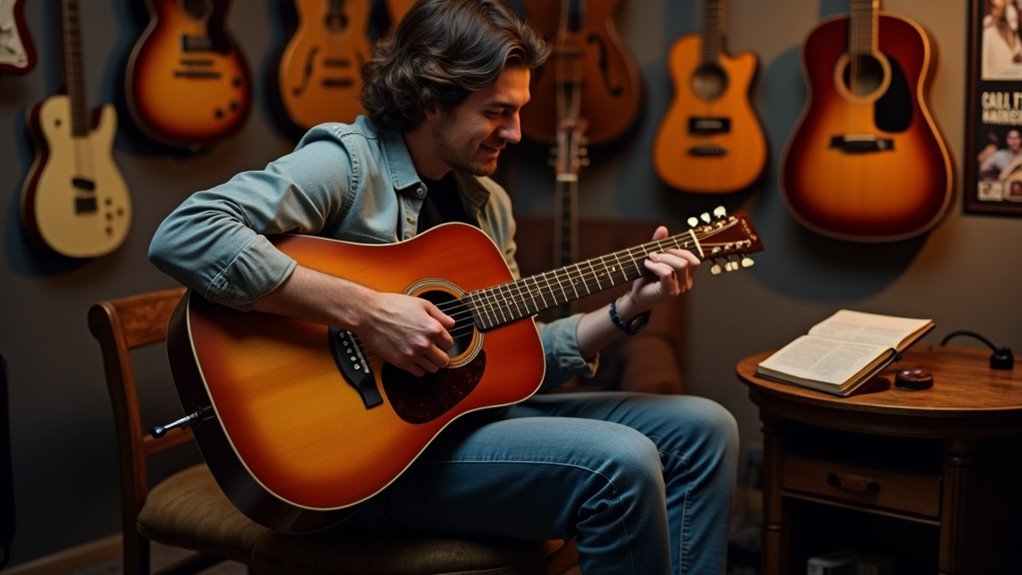Most guitarists spend years focusing on flashy solos while neglecting the backbone of great music – rhythm playing. We’re about to change that oversight. Let’s cut through the noise and get straight to what matters: mastering the techniques that’ll transform your choppy strumming into groove-driven excellence. Whether you’re stuck in basic patterns or ready to level up your game, we’ve got the blueprint to turn you into the rhythm powerhouse your band desperately needs.
Essential Rhythm Guitar Techniques Every Player Must Know

Five core techniques form the foundation of solid rhythm guitar playing, and we’ll help you master each one.
Let’s start with strumming patterns – they’re your bread and butter for better rhythm across all genres.
Next, we’ll tackle downpicking precision, a must-have skill that’ll boost your endurance and control.
Here’s the non-negotiable part: use a metronome. It’s not optional if you want rock-solid timing. Period.
Master your dynamics too – varying your attack intensity creates depth that flat playing never will.
Finally, get out there and jam. Nothing builds rhythm skills like playing with other musicians. It’s your real-world laboratory for testing everything you’ve learned.
Building Your Groove: Mastering Timing and Feel
Now that you’ve got those core techniques down, let’s sharpen your groove. Mastering timing starts with your best friend: the metronome. We’ll build your internal clock through consistent practice while incorporating dynamics to add depth to your playing.
| Practice Focus | Tool | Benefit |
|---|---|---|
| Timing | Metronome | Rock-solid rhythm |
| Feel | Dynamics | Textural depth |
| Flow | Subdivisions | Precise patterns |
Your strumming patterns need surgical precision. Break down complex rhythms into smaller parts, and don’t skip the groove-oriented genres – funk and reggae are masterclasses in feel. Join jam sessions regularly; there’s no substitute for real-time feedback from other musicians. Remember: timing isn’t just about being on beat – it’s about owning the space between those beats. That’s where true groove lives.
Genre-Specific Rhythm Methods and Patterns

Different genres demand distinct rhythmic vocabularies, and mastering them requires precise technique.
Let’s explore essential rhythm guitar patterns that define key styles. We’ll break down genre-specific approaches to transform your rhythm playing.
Here’s what you need to nail for each style:
- Metal rhythm: Fast downpicking with palm-muted power chords at 160+ bpm, emphasizing precise articulation.
- Punk: Aggressive downstrokes combined with power chords, maintaining raw energy.
- Funk: Tight 9th and 13th chords with minimal strumming, focusing on rhythmic precision.
- Jazz: Complex voice leading through chord progressions, weaving melody within rhythm.
Master these guitar techniques by practicing each style’s unique patterns.
Advanced Strumming Patterns and Variations
Moving beyond basic strumming opens up a world of rhythmic possibilities that’ll transform your playing from predictable to professional.
Let’s explore advanced strumming patterns that’ll set you apart: incorporate syncopation, triplets, and polyrhythms to enhance the groove of your playing.
We’ll start with palm muting – it’s your secret weapon for creating that essential percussive effect.
Combine it with ghost notes and strategic accents to add depth.
Ghost notes and strategic accents work together like seasoned dance partners, creating layers of subtle dynamics in your strumming technique.
Want to really challenge yourself? Experiment with 3/4 and 6/8 time signatures. They’re game-changers.
Here’s the non-negotiable part: practice with a metronome. Start slow, then gradually increase tempo.
This builds timing consistency that’ll hold up under pressure.
Developing Your Personal Rhythm Style and Sound

Finding your signature rhythm style isn’t about copying others – it’s about forging your own sonic identity. When you’re playing rhythm guitar, experimentation becomes your greatest ally in developing your personal sound. Record yourself, analyze your playing, and relentlessly refine your approach.
To improve your rhythm guitar playing, focus on these essential elements:
- Test different strumming patterns, from downpicking to fingerstyle.
- Study your favorite rhythm guitarists’ techniques and adapt them.
- Mix genres to expand your rhythmic vocabulary.
- Practice improvisation within familiar song structures.
Let your influences guide but not define you. Whether it’s funk chord stabs or palm-muted metal riffs, incorporate what resonates with your musical vision.
Frequently Asked Questions
How to Play Guitar More Rhythmically?
Let’s start with basic strumming patterns and timing exercises, then focus on groove development through consistent practice. We’ll work on smooth chord shifts while maintaining steady rhythm with a metronome.
What Is the Golden Rule of Guitar?
Picture yourself on a musical journey – it is understood that the golden rule of guitar is daily, consistent practice. It strengthens our guitar fundamentals, perfects strumming patterns, and sharpens timing techniques for lasting success.
How Long Does It Take to Be a Good Rhythm Guitarist?
We’ll typically see good rhythm skills develop in 3-6 months with regular practice frequency, though personal dedication affects progress milestones. Your skill assessment will show steady improvement through consistent weekly practice sessions.
What Should a Rhythm Guitarist Know?
Like a heartbeat keeps us alive, we’ll need mastery of strumming patterns, chord progressions, and timing techniques. Let’s develop our groove through consistent practice with these fundamental rhythm guitar elements.